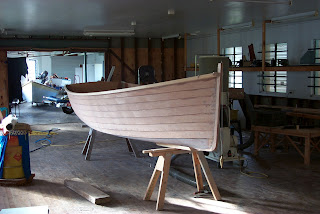You often hear designers describing the "lay" of planks. What does this mean? Well, depending on the form of a boat's hull, and the way in which the planking has been lined-off (another subject in itself), the shape of the individual planks when they are being marked out on the bench can be quite remarkable.
Here is an extreme example - the photo sequence shows the development of the sheer strake (top plank) of one of the
Bolger Hope designs which we built. The boat is quite wide for her length, and she has extreme flare in the forward sections. Phil Bolger told me that the lapstrake planking might be a bit difficult up there, and he was correct (as always).
 |
| Here you can see the temporary battens I used when carrying out the lining-off process. After establishing what I thought was a fair run of planking, tick marks were transferred to the molds and the battens were removed. |
 |
| Here you can see my son, Dave, marking the shape of the sheer strake onto the plywood planking material. He is tracing around the spiling batten which we had fabricated to lift the plank shape from the boat |
 |
| This photo shows just how severe the shape of the plank appears when laid out on the flat. But after being bent around the complex shape of the hull, everything looks normal. In the photo, the end closest to the camera is the bow end of the plank. |
 |
| With the planking complete, you can see that the strange and twisted shape of the plank pattern resulted in a nice, fair plank line on the finished hull. |
 |
| This picture shows another extreme. These are the topside plank patterns for an Eve 16 - a boat which has very little twist and concavity in here sections. You can see that the plank patterns are all very similar, with subtle shaping. |
 |
| This is the planked hull of the Eve 16 - the bottom was laid up with glued-strip planking |







I like what you are doing with the blog, Ross. Great Stuff! On another note, did you get to sail EVE? What did you think of the design? -- Dennis
ReplyDeleteThanks very much, Dennis. See the next article for a partial answer to your question.
ReplyDeleteRoss